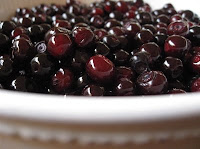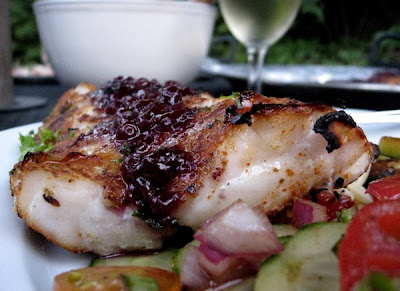 While scouting mushrooms in the mountains yesterday, I was reminded of a comment from a professional forager I interviewed this spring. “I always pay for my gas,” he said, the point being that foraging is a multi-disciplinary avocation and a good forager is knowledgeable on a wide variety of wild edibles—or, to traffic in cliche, when the gods give you lemons, make lemonade.
While scouting mushrooms in the mountains yesterday, I was reminded of a comment from a professional forager I interviewed this spring. “I always pay for my gas,” he said, the point being that foraging is a multi-disciplinary avocation and a good forager is knowledgeable on a wide variety of wild edibles—or, to traffic in cliche, when the gods give you lemons, make lemonade.
 The mushroom hunting was certainly a lemon yesterday. After such a good start with all that rain in August, September has been bone-dry. My chanterelle patch is a withered husk of its former self. We need rain badly. Yes, I’m sure there are mushroomers who are finding goodies in wetter micro-climates. That’s why I went for elevation yesterday—I figured there might be a little extra precip up there, at least some drip lines from early morning mist.
The mushroom hunting was certainly a lemon yesterday. After such a good start with all that rain in August, September has been bone-dry. My chanterelle patch is a withered husk of its former self. We need rain badly. Yes, I’m sure there are mushroomers who are finding goodies in wetter micro-climates. That’s why I went for elevation yesterday—I figured there might be a little extra precip up there, at least some drip lines from early morning mist.
Not likely. The roads are dusty and the duff is crunchy. Here and there I found the desiccated remains of old fruiting bodies, but otherwise the ground was bare. This was terra incognita for me, mostly a scouting run. I was on the Pacific Crest Trail and saw a total of four other hikers. Crossed paths with two backpackers and asked them how many nights. They looked a little embarrassed. “Five months,” one of them finally answered. Right on! I plan to do the through-hike one of these years. Passed an elderly couple out for a stroll. We talked about the poor huckleberry crop this year. The man said it was 10 percent of normal. If that’s true, expect to see newspaper stories about bears coming into town and raiding garbage cans. All around us the berry bushes were bare. Then, about two miles into my walk I started seeing them, big beautiful huckleberries like those we found in Indian Heaven earlier this summer.
Forget mushrooms; I screwed on my huckleberry snout.
Poor crop or not, it’s prime time for mountain huckleberries in the Pacific Northwest. Get ’em while you can. I love how the sun-exposed bushes turn fire-engine red this time of year.
Tips for Huckleberrying
1. Scout first. Look for patches producing the biggest, sweetest fruit. This will make the picking faster and easier. During my hike I covered about 7 miles and noted all the good patches so I could hit them on my return, at which point I was able to concentrate on chest-high bushes with lots of fruit that didn’t require any bending over. I saved my back the trouble and picked faster to boot.
2. Look for open slopes where fire or logging has removed much of the canopy. There is much debate among huckleberry hounds about the conditions that promote the best fruitings. Some evangelize full sun, while others pronounce the filtered light of open old-growth forests to be best. My own findings suggest that it isn’t so much the amount of sun or shade but the make-up of the bush. Spindly bushes will often have huge, sweet berries, with all their energy put into the fruit rather than the growth of leaves and stems. Be your own judge.
3. Know your huckleberries. Two of the most common in my neck of the woods are the thin-leaf huckleberry (Vaccinium membranaceum) and the oval-leaf huckleberry (Vaccinium ovalifolium), also known as the Alaskan blueberry. The former, with its large size and sweetness, is the most commonly harvested huckleberry in the PNW, while the latter is more sour and suitable for jams. Another less common species is the Cascade bilberry (Vaccinium deliciosum). There are more than a dozen species altogether in Washington and Oregon.
4. Two hands are better than one. Wear a jug around your neck. I didn’t have one on this trip, thinking I was mushrooming, but I improvised a plastic grocery bag that had contained my lunch, stretching one of the handles until I could fit it over my head and around my neck.
5. Pay attention. Mr. Bear has a stake in the berry brakes too!
Huckleberry Sauce
This sauce is so easy it’s criminal—and yet how nicely it tarts up (yeah, rockin’ the double-entendres) a grilled fillet of fish or a cut of meat. Really, you can make it however you like, but here’s what I did:
Simmered 4 cups of huckleberries with a cup of chicken stock, a cup of sugar, and 3 tablespoons of cider vinegar (several of the huckleberry sauces I checked online call for raspberry vinegar), then poured in a splash of tawny port a couple times, amounting in total to less than a half cup. I mashed half the berries and left the remainder whole. You might try crushed cloves, or white wine instead of port, or lemon zest, really whatever you want to jazz it up. A dab of butter to finish it gives the sauce a glisteny quality. I went for a fairly simple presentation and let the berries speak for themselves.
The sauce turned a fairly innocuous dish of grilled rockfish into something a little more special. The fish I rubbed with curry powder and a few other spices, then grilled. Topped with huckleberry sauce, the sparring between the curry and the berries made for, in Marty‘s words, an “awesome dinner!” Meanwhile, I’ve got a couple cups of sauce left in the freezer.

Like this:
Like Loading...

























